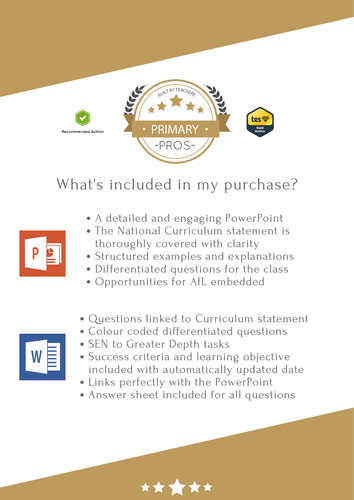





Please find within this download:
A detailed and engaging PowerPoint, Differentiated (SEN, LA, MA, HA, Mastery and Greater Depth) Worksheet with Answer Sheet for a complete lesson on this Year 6 addition, subtraction, multiplication and division statement: divide numbers up to 4 digits by a two-digit whole number using the formal written method of long division, and interpret remainders as whole number remainders, fractions, or by rounding, as appropriate for the context
The PowerPoint has the following features:
→ Differentiated starter activity
→ Extremely logical and simplistic explanations with animated examples and pictures to aid learning
→ Shows how to divide numbers up to 4 digits by a two-digit whole number using the formal written method of long division, and interpret remainders as whole number remainders, fractions, or by rounding, as appropriate for the context
→ Careful step by step guidance that can be moved forwards and backwards through
→ Many opportunities for AfL
→ Plenary activity
The Word Document has the following features:
→ Differentiated activities from SEN to greater depth
→ Coloured activity boxes to help you quickly assign tasks to children
→ Learning objective and short date which automatically show the correct date
→ Differentiated success criteria that link with the PowerPoint
→ Answer sheet included for all questions
Explore our other Year 6 Addition, subtraction, multiplication and division lessons:
Multiply multi-digit numbers up to 4 digits by a two-digit whole number using the formal written method of long multiplication
Divide numbers up to 4 digits by a two-digit whole number using the formal written method of long division, and interpret remainders as whole number remainders, fractions, or by rounding, as appropriate for the context
Divide numbers up to 4 digits by a two-digit number using the formal written method of short division where appropriate, interpreting remainders according to the context
Perform mental calculations, including with mixed operations and large numbers
Identify common factors, common multiples and prime numbers
Something went wrong, please try again later.
This resource hasn't been reviewed yet
To ensure quality for our reviews, only customers who have purchased this resource can review it
Report this resourceto let us know if it violates our terms and conditions.
Our customer service team will review your report and will be in touch.